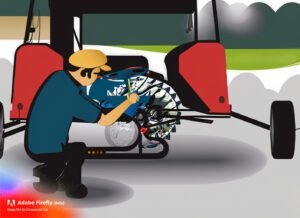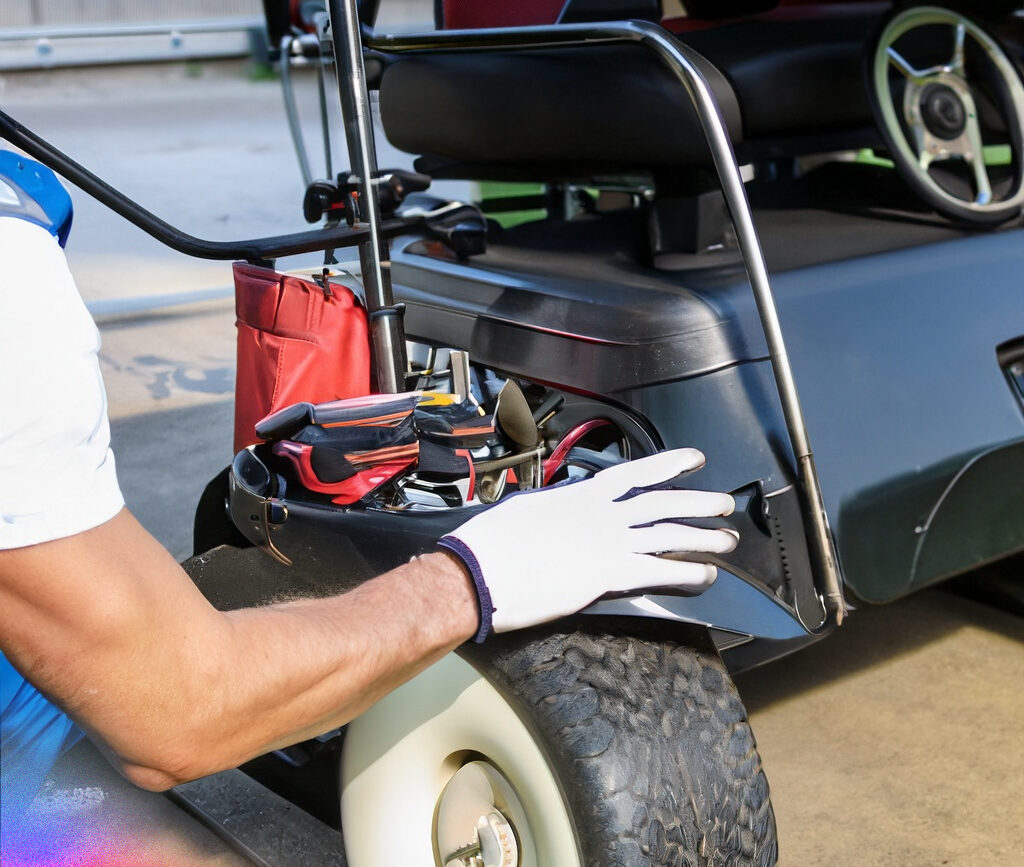Golf carts are a convenient mode of transportation on golf courses and other recreational areas. However, just like any other vehicle, they can experience problems, and one common issue is when a golf cart won’t start. This blog section will explore some of the reasons why a golf cart may fail to start and provide possible solutions to rectify the problem.
Common Issues with Golf Carts
Before delving into the specific reasons for a golf cart not starting, let’s first highlight some common issues that golf cart owners often encounter:
- Battery problems: Weak or dead batteries can prevent a golf cart from starting or cause it to lose power while in operation. Regular maintenance and charging are essential to ensure optimal battery performance.
- Ignition switch malfunction: A faulty ignition switch can disrupt the electrical flow and prevent the cart from starting. This issue requires professional assistance to diagnose and fix.
- Wiring issues: Corroded or damaged wiring can result in poor electrical connections, causing the golf cart to have problems starting or functioning correctly.
- Fuel delivery problems: Gas-powered golf carts may experience issues with fuel flow, such as clogged fuel filters or malfunctioning fuel pumps. These can affect starting and performance.
Why a Golf Cart Won’t Start
Now, let’s focus on the specific reasons why a golf cart may fail to start:
- Dead or weak battery: Insufficient battery charge is one of the most common culprits for a non-starting golf cart. Ensure that the batteries are adequately charged and have no loose or corroded connections.
- Ignition switch failure: A malfunctioning ignition switch can disrupt the electrical circuit and prevent the golf cart from starting. Consider having a professional inspect and replace the faulty switch if necessary.
- Blown fuse: A blown fuse can interrupt the power supply, leading to a non-starting golf cart. Check the fuses and replace any that are blown to restore proper functionality.
- Fuel issues: If you have a gas-powered golf cart, check the fuel levels and make sure there are no clogs or obstructions in the fuel system. It’s also advisable to use fresh and clean fuel to avoid starting problems.
- Electrical problems: Faulty wiring, loose connections, or damaged components can prevent the electrical system from working correctly, resulting in a non-starting or malfunctioning golf cart. Professional assistance may be needed to identify and resolve the issue.
By addressing these common issues and troubleshooting the specific reasons for a golf cart not starting, you can increase the chances of getting your cart up and running again. Remember to consult a professional if you encounter complex or persistent problems in order to minimize the risk of further damage or electrical hazards.
RELATED: How Many Seats Does A Golf Cart Have?
1. Battery Problems

Battery Connection Issues
One common reason why a golf cart may not start is due to battery connection issues. If the battery cables are loose or corroded, it can prevent the battery from delivering power to start the cart. It is important to regularly check the battery connections and ensure they are tight and free from corrosion. Tighten any loose connections and clean any corrosion using a battery terminal cleaner or a mixture of baking soda and water. Ensuring a solid and clean connection will help improve the electrical flow and increase the chances of the cart starting successfully.
Dead or Weak Battery
Another common issue that can prevent a golf cart from starting is a dead or weak battery. Over time, batteries can lose their charge, especially if they are not properly maintained or if the cart has been sitting unused for an extended period. Check the voltage of the battery using a voltmeter. A fully charged battery typically reads around 12.6 volts. If the voltage is significantly lower, it may indicate a weak or dead battery. Recharge the battery using a battery charger or replace it if necessary. It is important to note that the lifespan of a battery can vary depending on usage and maintenance, so regular battery maintenance is essential to prevent starting issues.
Here’s a quick summary of the possible battery problems and their solutions:
- Battery connection issues:
- Tighten any loose connections and clean any corrosion.
- Dead or weak battery:
- Check the voltage with a voltmeter. Recharge or replace the battery if necessary.
By addressing these battery-related issues, you can significantly increase the chances of your golf cart starting successfully.
2. Electrical System Issues

When a golf cart won’t start, it’s essential to consider potential issues with the electrical system. The electrical system plays a crucial role in powering the cart and getting it running smoothly. Here are some common electrical system issues that could be causing the problem:
Faulty Solenoid
A faulty solenoid is one of the most common reasons why a golf cart won’t start. The solenoid is responsible for connecting the battery to the starter motor, allowing the cart to start. If the solenoid is defective or worn out, it may not effectively transmit power, resulting in a non-starting cart. Replacing a faulty solenoid is relatively straightforward and can often resolve the issue.
Broken or Damaged Wiring
Another electrical system issue that can prevent a golf cart from starting is broken or damaged wiring. Over time, the wiring in the cart can become exposed to the elements or suffer damage from wear and tear. This can lead to electrical shorts or complete loss of power, preventing the cart from starting. Inspecting the wiring harness for any visible signs of damage and repairing or replacing any faulty wires can help resolve the issue.
It’s important to note that electrical system issues can be complex and may require the assistance of a professional to diagnose and repair. If you’re unfamiliar with electrical systems or unsure about how to proceed, it’s best to consult a qualified technician to avoid causing further damage.
Remember, these are just a couple of potential causes for a golf cart not starting. It’s always recommended to consult the owner’s manual and troubleshoot accordingly to pinpoint the exact issue. If the problem persists, seeking professional help is advised to ensure proper diagnosis and repair.
In the next section, we will discuss another common issue that can prevent a golf cart from starting: mechanical problems.
RELATED: What Maintenance Is Required For An Electric Golf Cart?
3. Fuel System Issues
When a golf cart refuses to start, it’s crucial to consider potential fuel system issues as the culprit. Here are two common fuel-related reasons why a golf cart won’t start:
1. Empty Fuel Tank
One possible reason for a non-starting golf cart is an empty fuel tank. Just like any other vehicle, golf carts require fuel to operate. If the fuel tank is empty or nearly empty, the engine won’t receive the necessary fuel to start and run. To resolve this issue, check the fuel level gauge or visually inspect the fuel tank to ensure there’s an adequate amount of fuel. Refilling the tank with the appropriate fuel should resolve the problem.
2. Clogged Fuel Filter
A clogged fuel filter is another common cause of a golf cart’s inability to start. Before the fuel reaches the engine, it must pass through the fuel filter, which removes dirt, pollutants, and other unwanted substances. Dirt, sediment, and other particles in the gasoline can accumulate in the fuel filter over time and cause it to become clogged, thereby reducing fuel flow. This can block fuel from getting to the engine, making it inoperable. A new gasoline filter should be installed if a dirty one is suspected. The golf cart may be revived by performing this straightforward maintenance procedure in order to restore normal fuel flow.
V. Starter Motor Problems
When your golf cart won’t start, there could be issues with the starter motor. The starter motor is responsible for initiating the engine’s rotation, and if it malfunctions, it can prevent your golf cart from starting. Here are two common starter motor problems that could be causing the issue:
Faulty Starter Motor
One possible reason why your golf cart won’t start is a faulty starter motor. Over time, the starter motor can wear out due to continuous use. This can result in problems such as the motor not spinning or spinning slowly. If you hear a clicking sound when you turn the ignition key, it could be a sign that the starter motor is failing. In this case, it is recommended to have a professional inspect and replace the faulty starter motor.
Ignition Switch Malfunction
Another potential cause of starting issues is an ignition switch malfunction. The ignition switch is responsible for sending an electrical signal to the starter motor when you turn the key. If the ignition switch is faulty or worn out, it may not send the proper signal, preventing the starter motor from engaging. In some cases, the ignition switch may need to be replaced to resolve the issue. A professional technician can diagnose the problem and determine if the ignition switch needs to be repaired or replaced.
If you’re experiencing starting problems with your golf cart, it’s essential to address the issue promptly. Ignoring the problem can lead to further damage and potentially more expensive repairs. Consulting a professional golf cart technician is recommended, as they have the expertise to diagnose and fix the problem effectively.
By understanding these common starter motor problems, you can troubleshoot and rectify starting issues with your golf cart. Remember, regular maintenance and inspections can help prevent these problems from occurring in the first place and ensure that your golf cart functions optimally.
Next up, we will discuss another common reason why a golf cart may not start: battery issues. Stay tuned for our next section on battery problems and their solutions.
4. Other Possible Causes

When your golf cart won’t start, there could be a few other possible causes that you should consider. Here are two common issues that can prevent your golf cart from starting:
1. Brake Pedal Interlock
One possible cause is a faulty brake pedal interlock. Many golf carts are equipped with a safety feature that prevents the cart from starting if the brake pedal is not fully depressed. This feature ensures that the cart cannot accidentally move while starting. If the brake pedal interlock is not functioning correctly, it may prevent the cart from starting even if all the other components are in good working order. In this case, you may need to have the interlock system checked and repaired by a professional technician.
2. Damaged Key Switch
A damaged or malfunctioning key switch is another possible reason of a non-starting golf cart. The key switch engages the electrical system and allows power to reach the ignition system. If the key switch is damaged or worn, it may not make adequate contact and the cart may not start. To remedy the issue, the key switch may need to be replaced in some circumstances. To diagnose and repair any problems with the key switch, it is best to consult a golf cart professional or a technician.
These are just a few of the other possibilities for a golf cart not starting. Before trying any repairs, properly troubleshoot and diagnose the problem. If you are confused about the problem or do not feel comfortable conducting the repairs yourself, it is best to seek professional help.
RELATED: How Does The Battery System Work In An Electric Golf Cart?
5. Troubleshooting Tips
Steps to Diagnose and Fix Golf Cart Starting Issues
If you’re experiencing trouble starting your golf cart, there could be several reasons behind it. The following troubleshooting tips can help you identify and resolve common starting issues:
Dead battery:
– Check the battery connections and ensure they are clean and tight.
– Use a voltmeter to test the battery voltage. If it reads below 12 volts, it may need to be recharged or replaced.
– Consider using a battery charger or jumper cables to boost the battery’s charge before attempting to start the golf cart.
Faulty ignition switch:
– Inspect the ignition switch for any signs of damage or corrosion.
– Test the switch using a multimeter to see if it is functioning correctly. If not, it may need to be replaced.
Fuel delivery issues:
– Verify that there is an adequate amount of fuel in the tank.
– Check the fuel filter for any clogs or debris that may be restricting fuel flow.- If necessary, clean or replace the fuel filter.
Problem with the starter motor:
– Listen for any unusual sounds coming from the starter motor when attempting to start the golf cart.- Inspect the starter motor for any visible damage.- If you suspect a problem with the starter motor, it may need to be replaced or repaired by a professional.
Ignition coil failure:
– Test the ignition coil using an ohmmeter to ensure it is functioning correctly.
– If the ignition coil is faulty, it will need to be replaced.
Remember, if you’re unsure about how to diagnose or fix any issues with your golf cart, it’s always best to consult a professional technician who specializes in golf cart repairs. They can provide expert guidance and ensure that your golf cart is running smoothly again.
By following these troubleshooting tips, you can identify and address the most common reasons why a golf cart may not start. Whether it’s a dead battery, faulty ignition switch, fuel delivery issues, problems with the starter motor, or ignition coil failure, diagnosing the issue correctly is the first step towards resolving the problem. With the right knowledge and resources, you can get your golf cart back on the course in no time!
Conclusion
After exploring the various reasons why a golf cart won’t start, it’s clear that there can be several underlying issues causing this problem. Here are some key takeaways and preventive measures for golf cart owners to keep in mind:
Key Takeaways
- A dead battery is one of the most common reasons for a golf cart not starting. Regular maintenance and ensuring the battery is properly charged can help prevent this issue.
- Faulty solenoids or wiring can also result in a golf cart failing to start. Regular inspections of the electrical system can help identify and fix any potential problems.
- Issues with the ignition switch or key can prevent the golf cart from starting. Testing the ignition system and replacing any faulty components can resolve this problem.
- Fuel-related issues, such as a clogged fuel filter or improperly mixed fuel, can also cause starting problems. Regularly cleaning or replacing the fuel filter and using the correct fuel mixture can prevent these issues.
- In some cases, a faulty starter motor or generator can be the culprit. Regular servicing and maintenance of these components can help prevent starting issues.
Preventive Measures
To avoid encountering starting problems with your golf cart, here are some preventive measures you can take:
- Perform regular maintenance on your golf cart, including checking the battery, electrical system, ignition components, and fuel system.
- Keep the battery properly charged and clean any corrosion on the terminals.
- Inspect and clean the electrical connections and wiring to ensure proper functioning.
- Use the correct fuel mixture and regularly clean or replace the fuel filter.
- Follow the manufacturer’s recommended maintenance schedule and have your golf cart serviced by a professional technician when necessary.
By following these preventive measures and addressing any potential issues promptly, you can keep your golf cart in optimal condition and minimize the chances of encountering starting problems.

I’m Donna Weiss, and I am the proud writer behind the captivating content you’ll find on golfneedy.com. As an avid golfer and passionate writer, I have combined my two greatest passions to bring you an incredible golfing experience. Through my articles, I aim to provide you with valuable insights, equipment reviews, and updates on the latest tournaments. Whether you’re a seasoned golfer or just starting out on this exciting journey, I am here to guide you and share my expertise. Together, let’s explore the fascinating world of golf, uncovering new techniques, and enhancing our skills. Join me on this thrilling adventure as we elevate our game and embark on an exciting golfing journey. Read More



